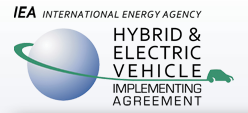The International Energy Agency's (IEA) Implementing Agreement for co-operation on Hybrid and Electric Vehicles Technologies and Programmes (IA-HEV) has released its 2013 Outlook, which identifies the factors for successfully deploying hybrid and electric vehicles.
It forecasts that hybrid and electric vehicles can dependency on oil and mitigate co2 emissions, especially when high shares of renewable electricity are used.
 29 August 2013: The International Energy Agency’s (IEA) Implementing Agreement for co-operation on Hybrid and Electric Vehicles Technologies and Programmes (IA-HEV) has released its 2013 Outlook, which identifies factors for successfully deploying hybrid and electric vehicles.
29 August 2013: The International Energy Agency’s (IEA) Implementing Agreement for co-operation on Hybrid and Electric Vehicles Technologies and Programmes (IA-HEV) has released its 2013 Outlook, which identifies factors for successfully deploying hybrid and electric vehicles.
The Outlook underscores that the following four conditions are necessary to foster the deployment of hybrid and electric vehicles: good timing when introducing technologies; involving all stakeholders in the development of a new vehicle technology; removing financial, psychological and practical uncertainties when a new product is introduced; and making electric vehicles financially attractive.
The Outlook also considers measures for impact and proposes that hybrid and electric vehicles sales can serve as a possible indicator for the success of e-mobility. The report measurements conclude that hybrids have become a mass-market product, plug-in hybrid electric vehicles are establishing a foothold in the market, and pure electric vehicles are still a niche product. It forecasts that hybrid and electric vehicles can reduce oil dependency and mitigate carbon dioxide (CO2) emissions, especially when high shares of renewable electricity are used. [IA-HEV Outlook Website][Publication: Implementing Agreement for co-operation on Hybrid and Electric Vehicles Technologies and Programmes Outlook 2013]